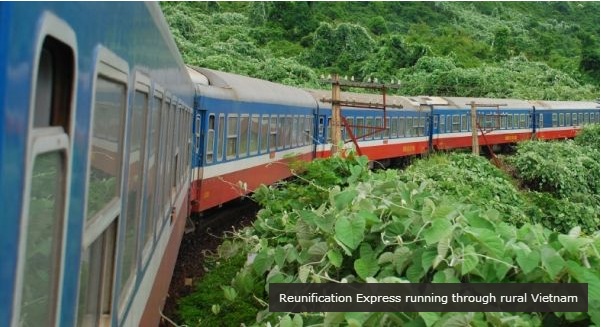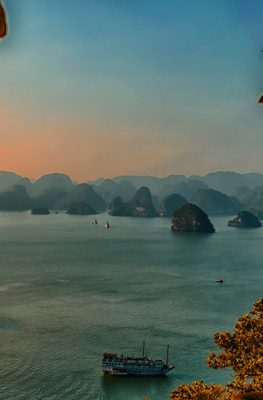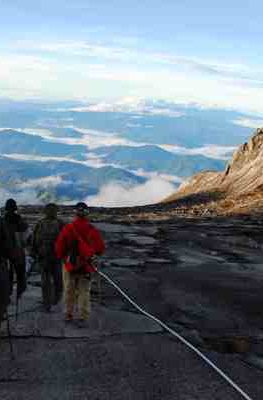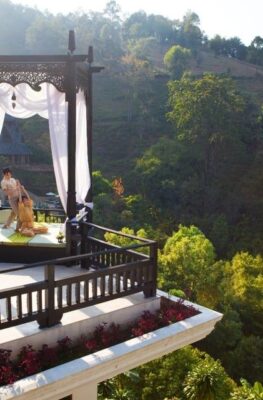Published on February 26, 2010

The gentle rocking of the train, the clickety-clack sound of the rails put you and your fellow passengers in a soporific mood and it’s time for another nap. But wait! The panorama of Vietnam unfolds just outside your window. Just when you thought you couldn’t keep your eyes open for another minute another only-in-Vietnam scene rolls by causing you to get out your camera for the umpteenth time. Nodding off once again in your soft sleeper train carriage, the Reunification Express chugs its way through a Vietnamese village, inches away from barber shops, cafés, and workshops. An octogenarian (an 80-something person) in her conical hat comes down the corridor wielding a tray tinkling with glasses of Vietnamese drip coffee. That nap will have to wait.
Vietnam Railway’s schedules have been prepared so that all long-distance trains leave in the evening to cut the monotony of travel along Vietnam’s long, thin geography. Passengers unload their belongings into a swirl of humanity, as the platform transforms itself into an instant marketplace. Throngs of vendors hawking rambutans, mineral water, and baguette sandwiches await. The heady mixture of aromas, playful kids, and haggling vendors comes to a crescendo as the train whistles and it’s time to push off.
Once the domain of pajama-clad Vietnamese farmers or intrepid adventurers, Vietnam Railways has upgraded its hardware and comforts in recent years. These days, you’ll more likely be sharing your compartment with Vietnamese businessmen, Australian families, and gap-year European students. The 2,000-kilometer long odyssey was the French colonial administration’s engineering jewel in the crown, completed in 1936. Much of the track lay in ruins during the ’70s, but the Vietnamese government made it a top priority to get the trains rolling to reunite North and South Vietnam once again, hence its name.
But even with its upgrades and faster speeds this is no bullet train or Orient Express. You’ll find no wood-paneled dining car with linen napkins or brass fittings in your compartment. The basic blue décor is a reminder that, after all, Vietnam is a socialist country that likes to keep things spartan and utilitarian. At the same time, the trains are remarkably punctual, clean, and efficiently run. The real perk is the fact that the train passes through some of Asia’s most dramatic landscapes, cutting swaths through emerald green rice paddies most of the way. By all accounts, the highlight of the line is the section between Hue and Danang through the Hai Van Pass. The tracks dramatically hug the coast of the South China Sea past untouched bays, fishing villages, and through the hills.
Some die-hard train aficionados will, of course, want to go all the way without stopping. But with all that Vietnam has to offer, why not get off at least once on your journey? Roughly halfway through the trip, Hoi An makes a perfect stop. Once upon a time, Hoi An was Southeast Asia’s busiest port. When traffic moved elsewhere, the town took a long nap. This preserved Hoi An’s unique architecture, now a UNESCO World Heritage Site. Chinese temples jostle Sino-Portuguese shophouses, while along the riverfront, elegant mustard-hued villas with colonnades remind us of colonial France. Chinese temples and assembly halls, vibrant with reds, golds, and fire-breathing dragons bring us back to Asia. Hoi An is so famed for its unique retro charm and great food, it’s not surprising that few think of it as a beach town. One of Southeast Asia’s broadest and cleanest beaches is a short bicycle ride away, with quiet surf and few people. Enjoy the serenity while it lasts.
Another UNESCO World Heritage Site is only an hour away. My Son Sanctuary was once the domain of the Champa Empire, stretching from India through Borobudur and Angkor Wat, complete with sculptures of gods, animals, and scenes of battle and devotion adorning the walls. After the fall of the Champa, the jungle reclaimed the site. Now, it’s in a state of atmospheric ruin and the number one excursion from Hoi An, not counting the beach.
Having rested up in Hoi An for a day or two, it doesn’t take long for the siren call of the rails to bring travelers back to continue their journey. Whether you settle in for the long haul or stop along the way, consider the words of E.M. Forster who once said “railway stations are our gates to the glorious and the unknown. Through them we pass into adventure and sunshine. To them, alas, we return.”
Go
Vietnam Railways (www.vr.com.vn/English) online has schedules and other info in English, but no railway booking. You can book through Aurora Travel at 37 Ly Nam De, Hoan Kiem District, Hanoi (tel. +84 4 3747 2597), or at Aurora Travel 1A Me Linh Square, District 1, Ho Chi Minh City (tel. +84 8 3823 3771; www.vietnamstay.com).
Click
The Man in Seat 61 (www.seat61.com/Vietnam.htm)covers railways all around the world with videos, timetables, maps, and advice on where the most scenic segments along the route are. Vietnam Railway is one of his favorites with lots of info and tips.
Stay
• Hoi An Hotel is a four-star hotel with branches in central Hoi An and another at Cau Da beach. – 10 Tran Hung Dao St.; tel. +84 510 386 1373;
• The Ha An Hotel, set in a restored French Colonial villa is popular, thanks to its gardens, architecture, and affordable rates from US$45. – 06-08 Phan Boi Chau, Hoi An; tel. +84 5 1086 3126; www.haanhotel.com
Dine
The Mermaid Café is THE place to eat in Hoi An. Madame Vy also has a cooking school on the other side of town in case you’d like to learn how to cook your favorites. Entrees start at US$3.
– 2 Tran Phu Street, Hoi An; tel. +84 5 1086 1527
Epic Train Journeys
India’s Palace on Wheels is a week-long experience that travels by night, giving passengers the chance to visit such attractions as the Taj Mahal, Jaipur, tigers in the Ranthabore National Park and the Thar Desert. – www.palaceonwheels.net
The Eastern and Oriental Express is the Southeast Asia version of the Orient Express. Journey from the elegance of Singapore to the excitement of Bangkok through the heart of Southeast Asia with visits to colonial Georgetown, Fort Cornwallis, and the infamous River Kwai from US$2,210.- www.orient-express.com
The Trans-Siberian Railway is the ultimate and longest railway adventure in the world. Book through www. realrussia.co.uk.
This article was provided by Philippine Airlines’ Mabuhay Magazine. Mabuhay Magazine is published by Eastgate Publishing Corporation (email: info@eastgatepublishing.com; website: www.eastgatepublishing.com).






